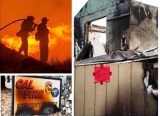Blog Post < Previous | Next >

FEMA
The City of Mill Valley is avoiding its firefighting responsibilities
When it comes to dealing with fire prevention and emergency preparedness, the City of Mill Valley can’t seem to get it right.
Last time around, they decided to reduce Mill Valley's main emergency evacuation route in the event of a catastrophic canyon fire, from two traffic lanes to one lane (a decision the Marin County Civil Grand Jury summarily rejected). They claimed that this as acceptable because any fire emergency could easily be handled by their "management" plan and the personal judgment of our Fire Chief.
This time, their lack of clear thinking has led to the draconian proposal of a “three-foot of hardscape” fire ordinance for homeowner’s in the Wildland Urban Interface.
For a comprehensive discussion of why the City’s newly proposed ordinance fails, see the comments by former mayor Dennis Fisco in his recently published letter to the Mill Valley City Council (click HERE).
The City Council, the City Manager, and the Mill Valley Fire Chief would have us believe that they have thoroughly considered their safety in coming up with the new ordinance and their “6 Steps to Defensible Space” booklet. However, the booklet takes an academic approach, which was essentially copied and pasted from recommendations written by Ed Smith, University of Nevada Cooperative Extension way back in 1997, for a situation that has little relevance to the facts and circumstances we face here in Marin.
It must be pointed out that even the Mill Valley booklet shows photos of solutions that have plantings right around houses, not as drastic as the 'no plantings within three feet of a home' regulations being proposed. Not only do photos show lots of plantings around homes but the captions brag that "A homeowner can have both an effective defensible space and an attractive landscape." And, if you read the background research, what it indicates is that what's most important is to remove large trees near structures, not little shrubs.
Ed Smith is the co-manager of the “Living With Fire program” which began when he and Paul Tueller of University of Nevada, Reno, and Fire Chief Loren Enstaad of the Sierra Front Wildfire Cooperators developed a specific set of wildfire threat reduction recommendations for Nevadans and then later decided to capitalize on that by offering conferences and consulting for Fire Departments across the country.
The problem is that the data points and experience used to create their recommendations were based on fires in the suburban foothills of Reno.
Reno sits next to the Sierra Nevada mountain range and has “cold desert” climate with 300 days of sunshine a year and annual rainfall of 7.48 inches (Mill Valley receives almost 50 inches annually, on average). In other words, suburban Reno could not be more unlike Mill Valley. For one thing, it’s in a high desert, not a coastal forest.
But it turns out there is one similarity. In 2011, Reno was placed on a government watchlist for its failing financial management and shady accounting practices. Like other poorly managed cities around the country their high salaries and benefits to city employees, unfunded pension liabilities, aging infrastructure costs, and over-taxed populace have left them few options. They’ve been trying to climb out of that financial hole ever since, mostly by cutting back on public services.
Though it's true that Reno's problems were exacerbated by the last economic downturn, it's my belief that planning for such inevitable events is part of the job of a City Manager and City Council, so I doesn't let them off the hook. Mill Valley and Marin County cities are headed in the same direction due their lack of planning and foresight. Marin cities are fundamentally no better off than Reno. They've just been lucky to be in a place where the epicenter of global tech is creating jobs faster than anywhere else. But luck is not a strategy. And taking your luck for granted, or worse, crediting one's own "genius" for the luck you've had -- as I often feel our City Manager and City Council to -- is a recipe for disaster.
The assumption in Marin is that the number of people living in or adjacent to high fire-hazard areas will inevitably increase – because the “growth at any price” political climate is unstoppable -- but our local firefighting resources will not be able to keep pace with the consequences. So what to do?
Historically, cities have responded to the challenge of protecting communities from fire catastrophes by hiring and training more firefighters and purchasing new equipment. But now the City’s tactic is to change the “messaging” to the public, from “protection of our community” to “preparation by the residents of our community.”
This slick marketing shifts the primary responsibility (and blame) of dealing with wildfire threats from the City to its residents. Meanwhile, as I described in detail in the article I published in January, the inevitable consequences of Mill Valley’s understaffed Fire Department and emergency response teams and the City’s lack of ability to deal with a catastrophic event are a disaster waiting to happen.
Mill Valley should not be relying on an old study about Reno’s suburban fire risks. They need to do their own studies and a thorough investigation of the facts and circumstances on the ground, in Marin. The Mill Valley City Council has to stop relying on the undocumented, personal opinions of its Fire Chief, who has done no studies of his own and whose opinion seems to always boil down to “Well, I’ve been a fireman for 35 years and based on that, I think…”
Sorry, but that's not very scientific.
It may be a clever way to exculpate the Council from future liability, but it’s not data the City can use to subject its residents to over-the-top regulations like the ones they’re now proposing.
